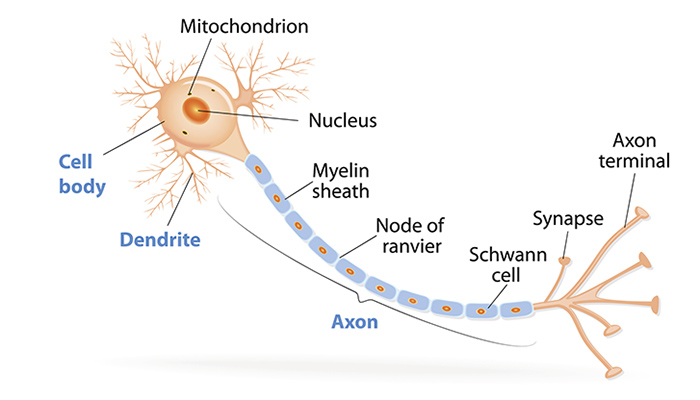Axons: the cable transmission of neurons

Each neuron in your brain has one long cable that snakes away from the main part of the cell. This cable, several times thinner than a human hair, is called an axon, and it is where electrical impulses from the neuron travel away to be received by other neurons.
Depending on the type of neuron, axons greatly vary in length - many are just a millimetre or so, but the longest ones, such as those that go from the brain down the spinal cord, can extend for more than a metre.
An axon typically develops side branches called axon collaterals, so that one neuron can send information to several others. These collaterals, just like the roots of a tree, split into smaller extensions called terminal branches. Each of these has a synaptic terminal on the tip.
Neurons communicate through synapses - contact points between the axon terminals on one side and dendrites or cell bodies on the other. Here, in a 20-40 nanometre-wide gap, electrical signals coming via the axon are converted into chemical signals through the release of neurotransmitters, and then promptly converted back into electricity as information moves from neuron to neuron.
Some axons are encased in a fatty substance called myelin, which is what makes your brain’s white matter white. Myelin acts as a form of insulation for axons, helping to send their signals over long distances. For this reason, myelin is mostly found in neurons that connect different brain regions, rather than in the neurons whose axons remain in the local region.
Axons and nerve degeneration
Neurons cannot properly communicate if axons are damaged or broken. This can happen both with nerve injury, and also in the earliest stages of neurodegenerative diseases such as motor neurone disease (MND), Alzheimer’s Disease and Parkinson’s Disease. Scientists at QBI are working to better understand the underlying processes and genetics involved.
Since axons are much longer than the rest of the cell, they need to be maintained by transporting essential molecules and organelles through them. QBI scientists have discovered that the gene mec-17 is involved in stabilising the internal neuronal structure to support proper transport within the axon and its maintenance. A mutation of this gene, and others with similar functions, can disrupt this process, leading to damaged axons and eventual disease.
QBI researchers have also discovered two proteins involved in axon degeneration in the roundworm C. elegans, a small organism which is an excellent research model for studying individual neurons and observing what happens at a molecular level. When an axon is damaged with a laser, it sends out signals to the surrounding tissue to be 'cleaned up', triggering the release of proteins that hastens degeneration of the axon. If such molecules are prevented from showing up, it could slow down the progress and extent of nerve damage.
Research that involves QBI scientists has also showed that severed neurons in roundworms (C. elegans) send out a 'save-me' signal to initiate nerve repair - to build a bridge to fuse the axon back together. This process was able to be modified by the researchers, giving hope for treating nerve injuries in humans in the future.
Image: istock
